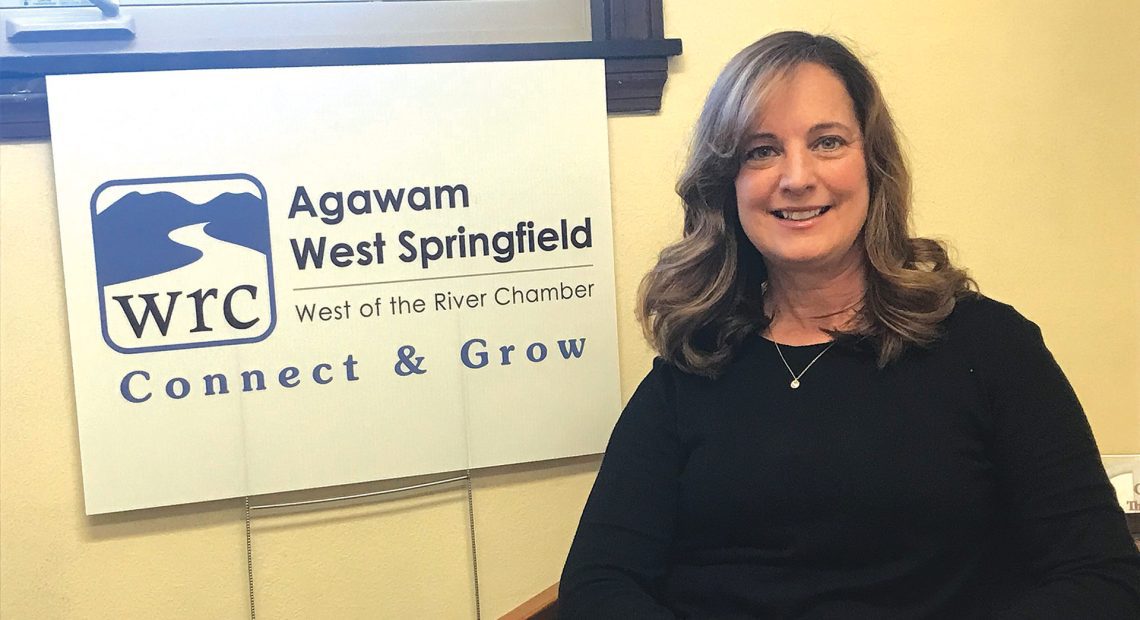Community Spotlight
By Mark Morris

Robin Wozniak says the chamber’s grant program is part of a broader effort to expand and diversify its support programs for businesses.
Like most area communities, Agawam continues to cope with the COVID-19 pandemic, while also making plans for the day when it is history.
That sentiment applies to the business community, the school system, infrastructure projects, and the local chamber.
“As we find our way back to a normal life, we are also trying to help people find new opportunities for success going forward,” said Robin Wozniak, executive director of the West of the River Chamber of Commerce (WRC), as she talked about the present and the matter of preparing for the future. “These are times when we are all learning and growing together.”
With that statement, she summed up the sentiments of many in this community of roughly 29,000, which, like most area cities and towns, has suffered greatly through the pandemic, but has also seen COVID yield some opportunities, which have come in many forms.
These include American Rescue Plan Act (ARPA) funds, which the city plans to use mostly on infrastructure projects (more on that later), some new businesses, and even an acceleration of the timetable for reconstructing the Morgan-Sullivan Bridge, which connects Agawam with West Springfield. The bridge work was to be completed later this year, but wrapped up more than six months ago, due in large part to a $1.5 million bonus from the state to incentivize the general contractor, Northern Builders, to get the work done sooner.
But gaining the roughly four weeks on what would have been shutdown time if the 2020 Big E had not been canceled certainly helped in those efforts.
The bridge project was undertaken to improve traffic flow in and out of the city and, ultimately, spawn new business opportunities in that section of the community, Mayor William Sapelli said. Time will tell what ultimately transpires, but already there are plans to develop a large vacant lot just over the bridge and a block from City Hall.
Colvest Group purchased the property several years ago, used it to park cars during the Big E, and leased it to the contractors as a staging area for the bridge-reconstruction work. Soon, it will advance plans to develop the property into three business parcels, including an office building and a Starbucks location.
“We could get a new roof and a good boiler and better windows, but the facility will still not be appropriate to meet our education needs for the 21st century.”
As for the chamber, it plans to step up its support of small businesses impacted by the pandemic through a grant program, Wozniak noted, adding that the WRC plans to begin awarding business grants starting in June and extend them through the end of the year.
“We’re planning to announce five $1,000 grants at our annual meeting in June and continue awarding grants into the summer and fall,” she said. “We’re excited to start the application process.”
Getting Down to Business
Before he became mayor in 2018, Sapelli was the long-time school superintendent in Agawam. And while his list of responsibilities is now much broader, the schools remain a primary focus.
And among the many issues to be addressed is the city’s high school.
A recent assessment of Agawam High School recommended $26 million in repairs to the building. Since 2002, the town has applied to the Massachuetts School Building Authority (MSBA) for consideration of a new high school. The MSBA looks at building conditions, as well as demographics and population trends, as part of its approval process.
While Sapelli has seen West Springfield, Chicopee, and Longmeadow all build new high schools, he’s encouraged because those projects actually help move Agawam up the list.

Mayor William Sapelli says Agawam is putting federal money to good use on everything from infrastructure to small-business support.
“One reason we’ve been overlooked was all the investments we’ve made over the years to maintain the building,” he said. Rather than continue to spend on the current high school — built in 1955 — he favors new construction.
“We could get a new roof and a good boiler and better windows, but the facility will still not be appropriate to meet our education needs for the 21st century,” he went on. If approved, the new school would be built on the practice fields adjacent to the current building.
A few years back, a new high-school building was proposed for the former Tuckahoe Turf Farm located near Route 187 and South Westfield Street. Now owned by the city, the 300-acre parcel will be developed into a passive recreation park for Agawam. Construction will begin in the spring to provide roads, parking areas, and access to a pond that will accommodate fishing, kayaks, and canoes.
A solar-energy installation is part of the parcel and will occupy nearly 50 acres of the land near South Westfield Street.
“The city will receive income from the solar array, which will help mitigate the costs to develop and maintain the property,” said Marc Strange, director of Planning and Community Development for Agawam. “The solar panels will occupy one small area of the parcel, leaving more than 200 acres for recreation and trails.”
While developing this long-vacant site, city leaders will continue to take steps to make the community more attractive for new business development.
As part of these efforts, infrastructure work is planned at the intersection of Springfield Street, North Street, and Maple Street, an area known as O’Brien’s Corner. This project, scheduled to start in the spring, will involve paving, adding curbs, and upgrading the traffic signals in the area.
Agawam received just over $8 million in funding from the American Rescue Plan Act (ARPA), which Sapelli plans to use on several stormwater infrastructure projects in town. Culverts on North Street and North Westfield Street have been temporarily repaired, but the state has made it clear both areas need a permanent solution. In addition, heavy rains are causing flooding problems on Meadow Street and Leland Avenue.
“Some of the puddles are so bad, people sent us photos of their neighbors going out in kayaks,” Sapelli said, adding that the photos helped emphasize the need for fixing these storm drains. “We are using the ARPA funds for what they are intended. These are projects that need to be addressed where we did not have the funding to do so.”
Agawam at a Glance
Year Incorporated: 1636
Population: 28,692
Area: 24.2 square miles
County: Hampden
Residential Tax Rate: $16.11
Commercial Tax Rate: $30.58
Median Household Income: $49,390
Family Household Income: $59,088
Type of government: Mayor; City Council
Largest Employers: OMG Inc., Agawam Public Schools, Six Flags New England, Whalley Computer Associates
* Latest information available
Beyond infrastructure, the city is using funds from various COVID-relief efforts to help the business community. Indeed, it secured a $200,000 Coronavirus Aid, Relief and Economic Security (CARES) grant designed to help micro-enterprises — five or fewer employees — in Agawam.
“These grants are designed to help these small-business owners with some relief until they can open their doors again,” Strange explained. “The grants help businesses that didn’t have access to other funds to help them.”
Meanwhile, the community is looking to support its beleaguered restaurants with an ordinance that will allow outdoor dining on a permanent basis.
“In the early days of the pandemic, outdoor dining was a lifesaver,” Sapelli said. “Now, going into the third year, it’s so popular, we are proposing an ordinance to make it permanent in Agawam.”
Giving Back
As for the chamber, its grant program is part of a broader effort to expand and diversify its support programs for businesses. For the past two years, the chamber has put its focus on keeping members up to date on health regulations, helping them identify grants they might qualify for, and any other information to keep them going.
“The last couple years have been all uphill for many of our members,” Wozniak said. “The chamber board feels the need to start giving back to our small businesses.”
Staying connected through events has been a long-time business model for chambers of commerce. Wozniak said she has reintroduced networking events with a hybrid twist where people can attend in person or take part remotely.
“We welcome those who feel comfortable going in person, and for those not yet ready, we offer a remote option so they can log on and enjoy the whole event from the safety of their home, remote office, or wherever.”
Wozniak reported the hybrid meetings have been successful because they help bring people face-to-face.
As she mentioned earlier, these have been times when business owners have been “learning and growing together.”
These efforts will hopefully yield dividends for the day when ‘normal’ is not a goal, but a reality.






